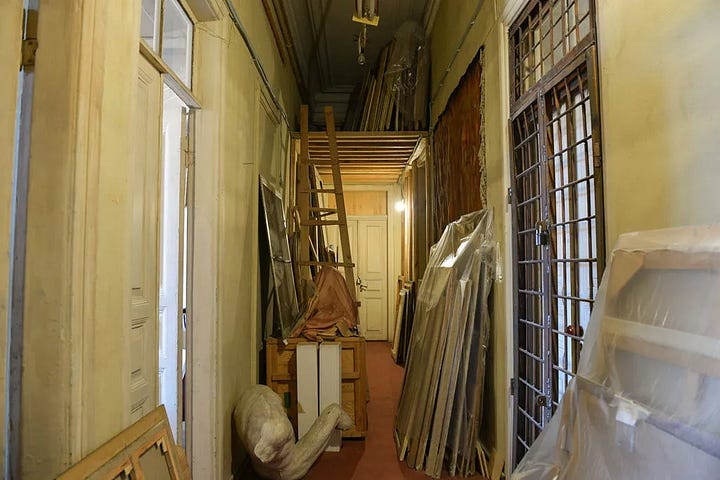Irresponsibility and Neglect: The Tragedy of Abkhazia’s National Art Gallery
Major Fire Devastates Central Exhibition Hall in Sukhum
SUKHUM / AQW'A — A catastrophic fire engulfed the Central Exhibition Hall in Sukhum, the capital city renowned for regularly hosting exhibitions of Abkhaz and international artists. The blaze resulted in the tragic loss of over four thousand artworks, including up to 300 pieces by Alexander Chachba-Shervashidze, a significant figure in Abkhazian art.
Dinara Smyr, the Acting Minister of Culture, conveyed to Apsnypress the enormity of the loss. "It's as if everything has been destroyed. The second floor housed the collections of the National Art Gallery, with over 4000 works. Among them were up to 300 works by Alexander Chachba-Shervashidze. This is an irreplaceable loss for the national culture of Abkhazia," Smyr emphasised, highlighting the cultural significance of the disaster.
The emergency services received the fire alert at 03:38. Eleven fire units from Sukhum, Gudauta, Galyrpsyh, and Ochamchira worked tirelessly to contain the blaze, which was eventually localized by seven in the morning. Smoke and visible flames were reported on the second floor where the fire was most intense.
A small portion of the paintings from the National Art Gallery's collection survived the fire that occurred last night at the Central Exhibition Hall of the Union of Artists of Abkhazia.
Among the surviving works are those by Viktor Sheglov, Khuta Avidzba, Sergey Sangalov, Golava, Sergey Gabelia, Visarion Tsvizhba, Tachulia, and Minasyan.
"I walk around and cry. It's terrible. According to the firefighters, the fire started on the roof of the building, likely due to an electrical short circuit. All the paintings burned. This is an irreparable loss for us. It's impossible to quantify the damage done to Abkhaz culture," said Suram Sakania, the director of the National Art Gallery.
The National Art Gallery's director, Suram Sakania, expressed his profound grief to Apsnypress. "I walk around crying. It's terrible. According to the firefighters, the fire started on the roof, likely due to an electrical fault. All the paintings are gone. The damage to Abkhazian culture is immeasurable," he lamented.




Irresponsibility and Neglect
In a tragic turn of event last night, the National Art Gallery of Abkhazia, a storied institution housing a vast collection of artworks, was ravaged by a fire, marking a severe blow to the nation's cultural legacy. This catastrophe underscores years of neglect and mismanagement by Abkhazian officials, exposing a systemic disregard for the preservation of art and history.
The National Art Gallery, established in the 1960s, has long been a repository for both Abkhaz and international art. Its journey from a modest facility on Pushkin Street in Sukhum to its relocation to Lakoba Street pre-Patriotic War (1992-1993) was marked by challenges, yet the collection had miraculously survived the war. However, the post-war period witnessed a continuation of the gallery's struggles, exacerbated by broken promises and financial neglect.


The dire conditions in which these priceless artworks were stored were poignantly described by the gallery's Director, Suram Sakania. "The dampness caused the paintings to swell and the colours to crack. Proper storage requires individual casing for each artwork, a luxury we could not afford. We did our best to protect the most iconic works, including those of Chachba-Shervashidze and Bubnova, within our limited means," he stated, highlighting a painful narrative of neglect.
Despite repeated inspections and promises of improvements, the gallery's precarious situation remained unchanged. A 2011 proposal for including the gallery in the Investment Program was ignored, and subsequent pleas for assistance were met with indifference.
The fire, which engulfed the gallery last night, is not merely a loss of artistic works but a glaring indictment of the Abkhazian government's priorities. This incident reflects a profound disconnection between the state's duties and its actions, where the safeguarding of national heritage has been grossly overlooked.
As cultural commentator Larisa Khadzhimba lamented, "4,000 invaluable paintings, a testament to our republic's glory, were lost due to gross negligence in art conservation and fire safety."
In the words of Richard Chkadua, "Our cultural foundation has been eroded. Future generations will judge us harshly for this loss."
This tragedy is more than a cultural loss; it is a wake-up call to the nation. It highlights the urgent need for a responsible governance that prioritises the protection and preservation of Abkhazia's cultural and historical assets.



